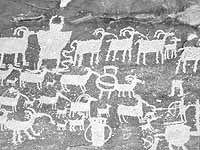| The rock art in Nine Mile Canyon are some of the best in the world. Rock art exists in almost every country, but the examples in Carbon County are outstanding. |
Nine Mile Canyon
Nine Mile Canyon is known as a major representative area of the prehistoric Fremont Culture and is a must when planning a day trip in Carbon County
What can I see and do?
Dry climate and isolation have allowed Nine Mile Canyon to remain virtually untouched for hundreds of years. Nine Mile is an outdoor museum with remarkable examples of Native American rock art and remnants of dwellings. The area contains the greatest concentration of rock art in the United States. The rugged, remote canyon begins 20 miles north of Wellington and stretches 40 miles along the northern side of the Book Cliffs. The Nine Mile rest area offers toilets, picnic tables, dispersed camping and group facilities.
The canyon houses myriad rock art panels along the main road and in side canyons. Petroglyphs, which are carvings on rack faces and pictographs, which are paintings on rock faces, depict animals, hunting scenes and iconic figures.
Careful observers may spot cliff granaries on high canyon ledges. In the 1800’s the canyon was used by both fur trappers and the army. Iron telegraph poles, stages stations and settler cabins are common sights. Vegetation and terrain along this backroad area vary from high desert species to aspen groves. The buff colored cliffs of the canyons are highlighted by balanced rocks and window arches. Deer and elk are frequently seen.
Day Tripping Map |
How do I get there?
A back country byway kiosk greets visitors at the southern entrance to the canyon from U.S. Highway 6 and there are several signs to keep travelers on track. After the paved 12 miles from U.S. 6, the byway is a narrow dirt road, with several blind corners. From Price, travel east through Wellington for 7.5 miles to the Nine Mile Canyon turnoff. Turn left or north.
Visitors need to be careful of the large amount of private property that exists in the canyon.

